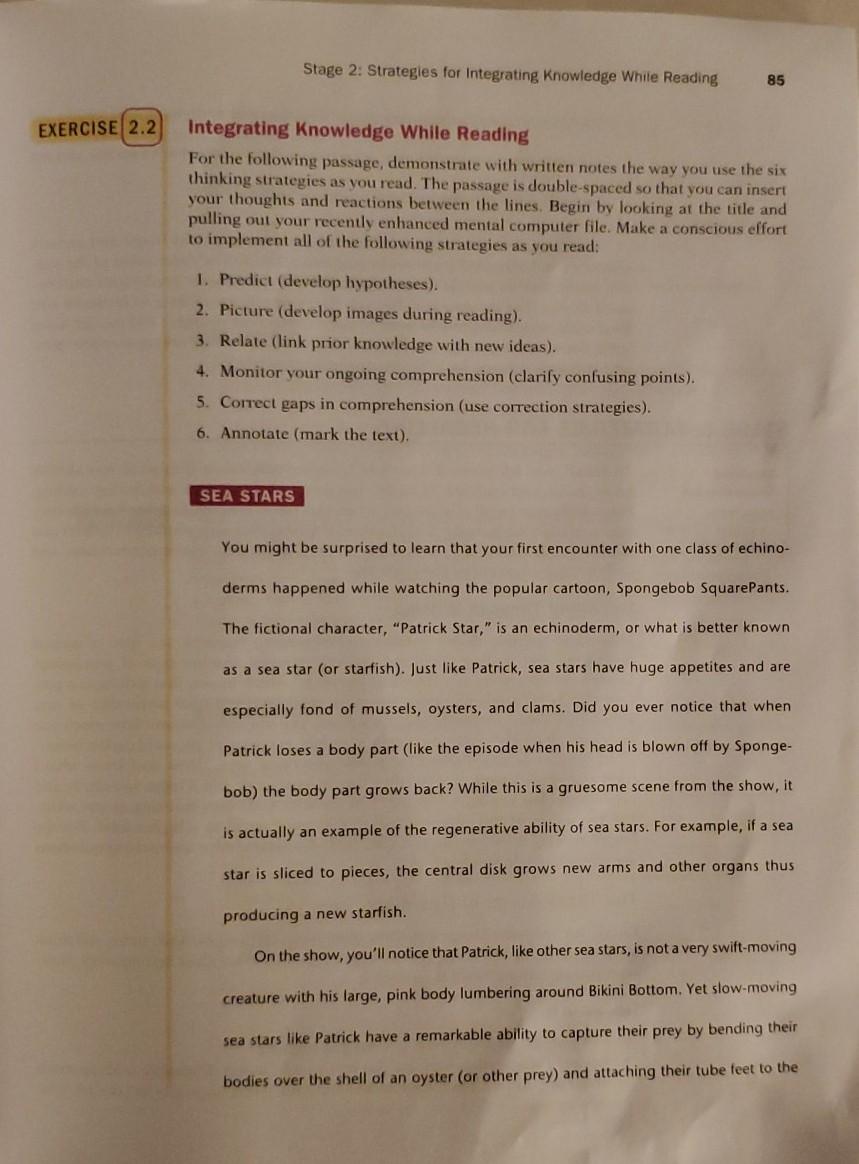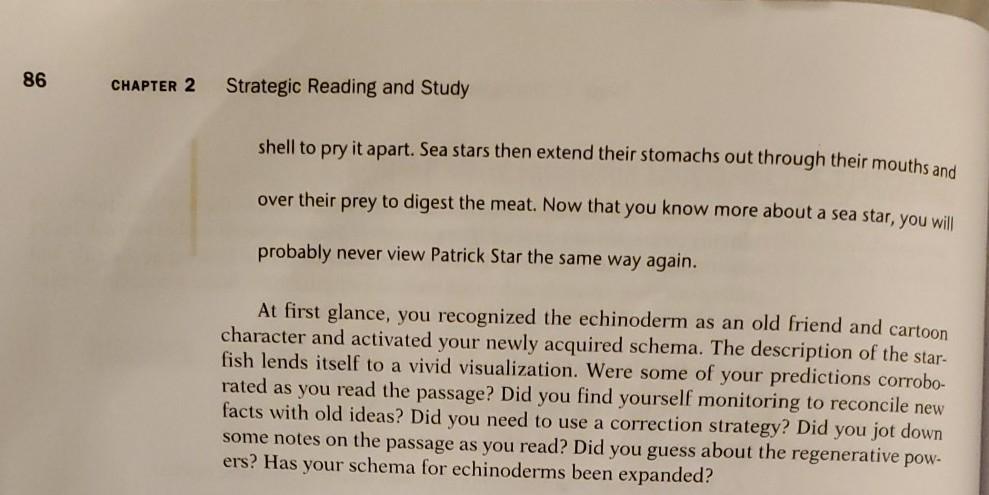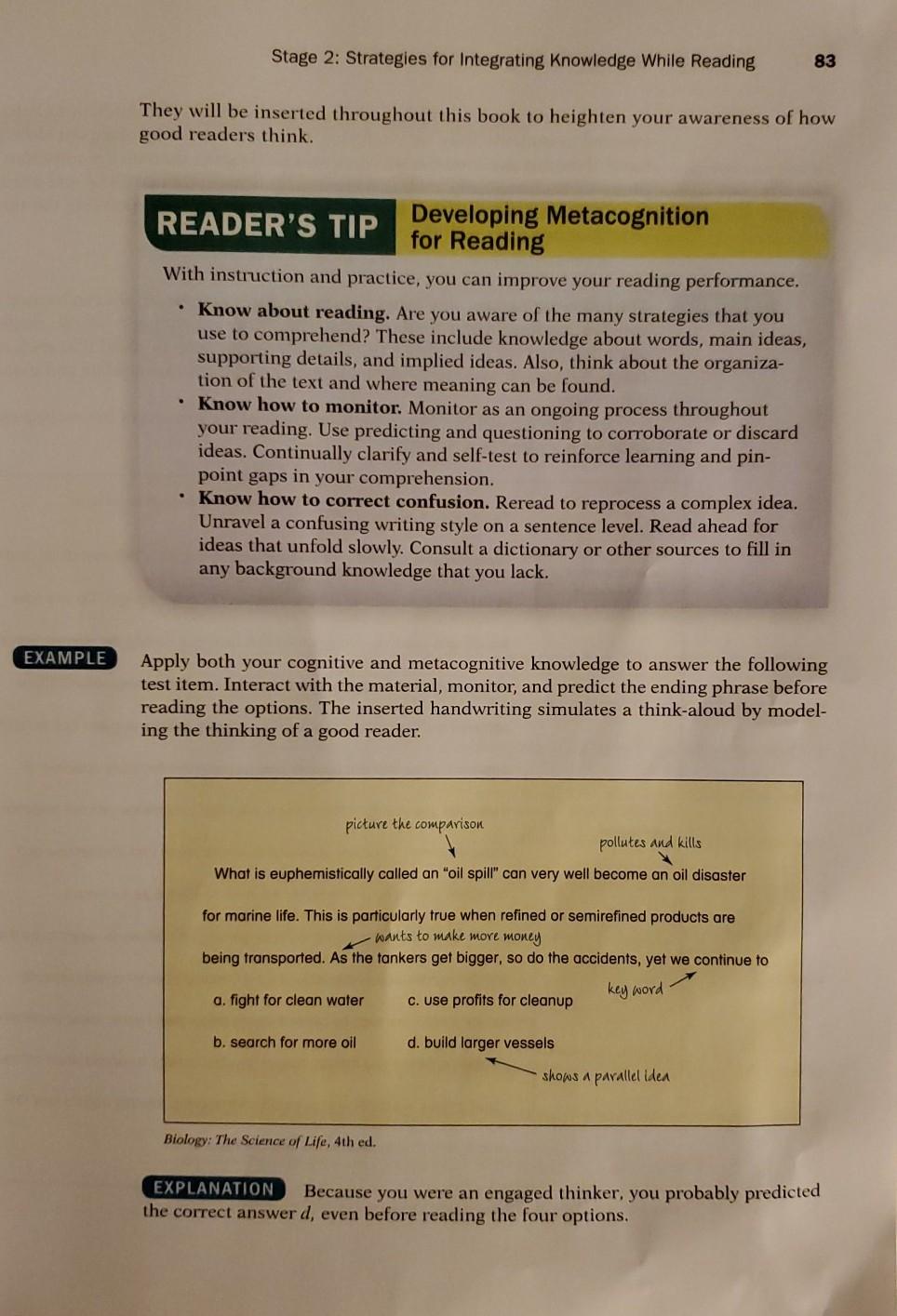Answered step by step
Verified Expert Solution
Question
1 Approved Answer
that's all I have information.. Stage 2: Strategies for Integrating knowledge While Reading 85 EXERCISE 2.2 Integrating knowledge While Reading For the following passage, demonstrate





that's all I have information..
Stage 2: Strategies for Integrating knowledge While Reading 85 EXERCISE 2.2 Integrating knowledge While Reading For the following passage, demonstrate with written notes the way you use the six thinking strategies as you read. The passage is double-spaced so that you can insert your thoughts and reactions between the lines. Begin by looking at the title and pulling out your recently enhanced mental computer file. Make a conscious effort to implement all of the following strategies as you read: 1. Predict (develop hypotheses). 2. Picture (develop images during reading). 3. Relate (link prior knowledge with new ideas). 4. Monitor your ongoing comprehension (clarify confusing points). 5. Correct gaps in comprehension (use correction strategies). 6. Annotate (mark the text). SEA STARS You might be surprised to learn that your first encounter with one class of echino- derms happened while watching the popular cartoon, Spongebob SquarePants. The fictional character, "Patrick Star," is an echinoderm, or what is better known as a sea star (or starfish). Just like Patrick, sea stars have huge appetites and are especially fond of mussels, oysters, and clams. Did you ever notice that when Patrick loses a body part (like the episode when his head is blown off by Sponge- bob) the body part grows back? While this is a gruesome scene from the show, it is actually an example of the regenerative ability of sea stars. For example, if a sea star is sliced to ces, the central disk grows new arms and other organs thus producing a new starfish. On the show, you'll notice that Patrick, like other sea stars, is not a very swift-moving creature with his large, pink body lumbering around Bikini Bottom. Yet slow-moving sea stars like Patrick have a remarkable ability to capture their prey by bending their bodies over the shell of an oyster (or other prey) and attaching their tube feet to the 86 CHAPTER 2 Strategic Reading and Study shell to pry it apart. Sea stars then extend their stomachs out through their mouths and over their prey to digest the meat. Now that you know more about a sea star, you will probably never view Patrick Star the same way again. At first glance, you recognized the echinoderm as an old friend and cartoon character and activated your newly acquired schema. The description of the star- fish lends itself to a vivid visualization. Were some of your predictions corrobo- rated as you read the passage? Did you find yourself monitoring to reconcile new facts with old ideas? Did you need to use a correction strategy? Did you jot down some notes on the passage as you read? Did you guess about the regenerative pow- ers? Has your schema for echinoderms been expanded? Stage 2: Strategies for Integrating Knowledge While Reading 83 They will be inserted throughout this book to heighten your awareness of how good readers think. READER'S TIP Developing Metacognition for Reading With instruction and practice, you can improve your reading performance. Know about reading. Are you aware of the many strategies that you use to comprehend? These include knowledge about words, main ideas, supporting details, and implied ideas. Also, think about the organiza- tion of the text and where meaning can be found. Know how to monitor. Monitor as an ongoing process throughout your reading, Use predicting and questioning to corroborate or discard ideas. Continually clarify and self-test to reinforce learning and pin- point gaps in your comprehension. Know how to correct confusion. Reread to reprocess a complex idea. Unravel a confusing writing style on a sentence level. Read ahead for ideas that unfold slowly. Consult a dictionary or other sources to fill in any background knowledge that you lack. EXAMPLE Apply both your cognitive and metacognitive knowledge to answer the following test item. Interact with the material, monitor, and predict the ending phrase before reading the options. The inserted handwriting simulates a think-aloud by model- ing the thinking of a good reader. picture the comparison pollutes and kills What is euphemistically called an "oil spill" can very well become an oil disaster for marine life. This is particularly true when refined or semirefined products are wants to make more money being transported. As the tankers get bigger, so do the accidents, yet we continue to a. fight for clean water c. use profits for cleanup key word b. search for more oil d. build larger vessels shows a parallel iden Biology: The Science of Life, 4th ed. EXPLANATION Because you were an engaged thinker, you probably predicted the correct answer d, even before reading the four options. inserted comments may be confusing to read because involvement differs and In this test item as well as in the passage on Technology Addictions below, the many thoughts occur on the subconscious level rather than on the conscious level, Stopping to consciously analyze these reactions may seem artificial and disruptive. The following passage illustrates how Stage 2 thinking strategies can be used when you are reading longer textbook material. Modeled thoughts of the reader are again inserted for a simulated think-aloud. Again, keep in mind that each reader reacts differently to material depending on background knowledge and individual It is important, however, to be aware of how you are incorporating the thinking Exercise 2.2 will heighten your awareness of the process of interacting analyti- Strategic Reading and Study 84 CHAPTER 2 strategies into your reading. EXAMPLE differences. cally with a piece of writing. What do I already know about this? Technology Addictions Have you ever opened your web browser to quickly check something, and an Sounds Familiar Am I addicted? hour later found yourself still checking your Facebook page? Do you have friends who seem more concerned with texting or surfing the internet than with eating, going out, studying, or having a face-to-face conversation? These attitudes and behaviors are not unusual; many experts suggest that technology addiction is real and can present serious problems for those addicted. An Source of these estimated one in eight internet users will likely experience internet addiction. statistica Approximately 11 percent of college students report that internet use and computer games have interfered with their academic performance. Some online activities, such as gaming and cybersex, seem to be more Serious aguptows compelling and potentially addictive than others. Internet addicts typically exhibit symptoms such as general disregard for their health, sleep deprivation neglecting family and friends, lack of physical activity, euphoria when online, lower grades in school, and poor job performance. Internet addicts may feel Concerning but not-moody or uncomfortable when they are not online. A1 serious Rebecca Donatelle, Health: The Basies. 12th ed. 81 Stage 2: Strategies for Integrating knowledge While Reading READER'S TIP Using Thinking Strategies While Reading Predict. Develop hypotheses. "From the title, I predict that this section will give another example of a critical time for rats to learn a behavior." "In this next part, I think we'll find out why the ancient Greeks used mnemonic devices." "I think this is a description of an acupuncture treatment." Picture. Develop visual images during reading. "I have a picture of this scene in my mind. My pet is lying on the table with acupuncture needles sticking out of its fur." Relate. Share an analogy. Link prior knowledge with new information in the text. We call this the "like-a" step. "This is like my remembering, 'In 1492, Columbus sailed the ocean blue. Monitor your ongoing comprehension. Be aware of whether you understand the material. "This is confusing." "This just doesn't make sense. How can redwoods and cypress trees both be part of the same family?" "This is different from what I had expected." Correct gaps in comprehension. Use fix-up correction strategies. "I'd better reread." "Maybe I'll read ahead to see if it gets clearer." "I'd better change my picture of the story." "This is a new word to me. I'd better check the context to figure it out." Annotate. Mark the text by circling major details, underlining minor ones, and making brief notes in the margin. Annotating like this sorts the information now for study laterStep by Step Solution
There are 3 Steps involved in it
Step: 1

Get Instant Access to Expert-Tailored Solutions
See step-by-step solutions with expert insights and AI powered tools for academic success
Step: 2

Step: 3

Ace Your Homework with AI
Get the answers you need in no time with our AI-driven, step-by-step assistance
Get Started


